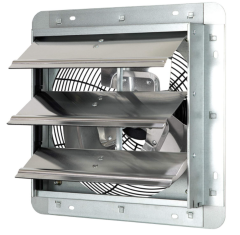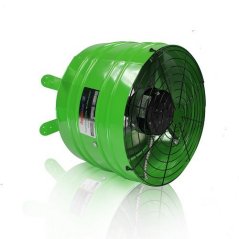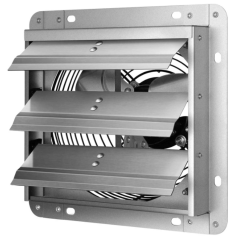
An efficient attic fan capable of moving 1,945 cubic feet per minute.
An efficient attic fan capable of moving 1,945 cubic feet per minute.
This attic fan is fairly easy to install thanks to its plug-and-play design and included vent covers. The built-in thermostat works reliably, as does the two-speed function. Powerful enough for larger attics and homes.
Though it's rated for 14 decibels, some customers found this fan to be fairly loud.

A powerful fan for the money, but it only works well in small attics.
A powerful fan for the money, but it only works well in small attics.
Comes fully assembled. Makes a big difference in air quality and temperature for a small amount of money. Has several speeds. Services up to 900 square feet.
Installation requires hard wiring. Thermostat and remote sold separately.

Despite a few quirks, this value-priced attic fan is a good choice for large attics and limited budgets.
Despite a few quirks, this value-priced attic fan is a good choice for large attics and limited budgets.
Powerful and affordable exhaust fan that's ideal for spaces up to 1,850 square feet. Provides outstanding ventilation. Constructed of durable galvanized steel. Easy installation.
Some reports of the built-in thermostat not working. Occasionally gets off balance during operation.

For ease of installation and cooling a large space, this is a good bet.
For ease of installation and cooling a large space, this is a good bet.
Includes a thermometer and humidifier to start and stop itself. Self-adjusting speed. Plugs in. Quiet operation. Can cool up to 4,800 square feet.
It may automatically stay on all the time if the humidity and temperature are right.

A low-priced fan that is easy to install, if you don't mind a little noise.
A low-priced fan that is easy to install, if you don't mind a little noise.
Makes a big difference in your attic heat, and the price is low. You can tailor the temperature to the local climate. Affordable.
Not as quiet as some other options.

We recommend these products based on an intensive research process that's designed to cut through the noise and find the top products in this space. Guided by experts, we spend hours looking into the factors that matter, to bring you these selections.

Ready to buy now? Shop the best:
On a hot day, the temperature in your attic can reach 150°F or more. That makes it difficult to cool your house, and it could even damage parts of your roof structure. Modern building regulations say you must have roof vents, but they’re passive – they don't do anything to create airflow. That's where an attic fan comes in – actively drawing the hot air out.
Attic fans are a simple, popular, and cost-effective solution to an overheated roof space. They are relatively easy to install, and once fitted, these fans require virtually no maintenance. You'll probably forget it's there.
There are many different attic fan models to choose from, so BestReviews is here to help you. We’ve researched the market and come up with some recommendations that can simplify your buying decision. We've also put together an attic fan shopping guide full of information to answer your questions. When you’re ready to buy, check out our top picks in the product list.

There are two devices commonly called “attic” fans: the whole house fan and the attic venting fan. Both are for cooling, but what they cool and the way they do it differ. An attic venting fan is a basic yes or no decision. You either want one or you don't. With a whole house fan you will probably also need to consider other cooling elements, such as ceiling fans and/or air conditioning.
Function: The whole house fan is designed to pull air right through your house, cooling and refreshing as it does so. These fans exhaust into the attic space, which is okay because they're moving fresh, not hot, air. These fans lower the temperature in the attic as well.
You usually run a whole house fan at night. In moderate climates, these are frequently used instead of air conditioning, particularly in conjunction with a ceiling fan. In hotter areas, they are often used in conjunction with an air conditioner.
These are big fans – 24 inches or more in diameter – for two reasons. First, you need a big fan for sufficient airflow. Second, a large fan working slowly is much quieter than a small fan working hard, and the last thing you want at the center of your home is a noisy fan.
Installation and specs: Whole house fans, by their nature, are installed indoors, in the attic floor (or upstairs ceiling) in a central location in the house. A louvered (slatted) panel minimizes the visual impact. The main body of the fan is usually steel (galvanized is best). Blades can be steel or aluminum. Often the fan is pre-mounted on a wooden frame, making installation easier. The motor drives the fan via a belt (usually quieter) or direct gear.
Considerations: It's important that the windows be open when running a whole house fan, or it can create a vacuum that leads to backdrafts that can extinguish pilot lights on gas water heaters or furnaces. Backdrafts can also pull dangerous carbon monoxide from water heaters and furnaces into the house instead of venting to the outside as normal.
Whole house fans can be great at keeping your home at a comfortable temperature so long as you take into account how they work most efficiently. Not everyone wants to have their house open all night. If you only open upstairs windows, the idea is still sound, but you're reducing the fan’s efficiency.
Function: Attic venting fans are also called attic fans, attic ventilators, and attic exhaust fans. These fans regularly clear the hot air from the attic to allow cooler air in. Even on scorching summer days, the air outside your house is nowhere near as hot as the air trapped inside the attic.
Installation: These fans sit in a gable end or in the sloping part of the roof.
Considerations: An attic venting fan only works on the air in the roof space, but in many cases, it can help cool the entire home. Pipes or trunking that run through the roof space and into the rest of the house can conduct heat from the attic. Cooling that air dramatically reduces the transfer effect, so your air conditioner doesn't have to work so hard. There are a number of solar-powered options on the market as well.
The most important figure when it comes to attic fans is cubic feet per minute (cfm), the volume of air the fan moves. The bigger the house (for whole house fans) or attic space (for attic venting fans), the higher the cfm figure you need. Some fans are twin speed, so two cfm ratings are given. Motor power (given in amps or horsepower) isn't a major factor so long as it generates the required cubic feet per minute.
Some manufacturers tell you their fan works in spaces up to 1,000 square feet or from 2,000 to 3,000 square feet, for example. It's another useful guide, but you can't always be sure how the company arrived at that figure. Cubic feet per minute is a more definite number.
Attic fans are either gable or roof mounted. Gable installation means you don't have to get out on the roof. You'll do most, if not all, of the work from inside the attic. Again, these are mostly of steel construction. Cheap attic fans may be supplied without a louver, so you'll probably want to add one. With roof-mounted attic fans it's particularly important to follow installation instructions carefully. Get it wrong and you'll have water in the house the next time it rains!
Fans of all kinds often have thermostatic controls, though it may come at extra cost. With attic fans, it's usually on a cord or cable, enabling you to position it some distance from the fan itself. This means readings won’t be affected by rapidly moving air.
There are lots of solar attic fans available, with the obvious attraction that they cost nothing to run. The underpinnings of most are similar to wired fans, though the best are designed to make the most use of the solar energy available.
The drawback isn't the availability of sunlight – modern photovoltaic cells make good use of even relatively modest light levels. If you've got a roof that's often in the shade, there are even fans that allow you to mount the energy panel remotely.
The main problem is the comparatively low amount of electricity generated. Solar attic venting fans generally have a much lower cfm rating than a similarly priced traditional model. If you choose carefully, the drawbacks will be slight because an attic fan is a low-consumption device anyway. It's important to check the specifications carefully because some manufacturers shy away from giving cfm figures.
Expect to pay between $50 to $400 and up for an attic fan, depending on the type and quality.
You'll find cheap gable-mount attic fans for between $50 and $75. These are likely to be small with relatively low cfm ratings. Louvres or shutters may not be included (you can buy them separately or do without if you don't mind the appearance).
There are surprisingly few attic fans that cost between $75 and $200. What you'll find are either high-quality but relatively small wired models or entry-level solar fans.
As quality and size go up, so do prices. Larger, higher-specification attic and whole house fans – those between 24 and 30 inches – range from $200 to over $400.
At the moment, solar attic fans are considerably more expensive than similar-size wired models. While these fans use no additional power, it takes many years to recoup the difference in cost. The main reasons for choosing a solar fan are ease of installation and environmental considerations.

Check out hybrid attic fans. Obviously, solar fans don't work well at night! If you want the daytime advantages of solar, and the ability to run your fan after the sun goes down, look at hybrid models. These can automatically switch to your household electricity if there's not enough solar power being generated.
Calculate fan size accurately. There's no point choosing either a whole house or attic venting fan that’s too small. You'll just be spending good money on an installation that won't do the job efficiently. Too big a fan can also cause problems. Insufficient air flow through the fan can cause overheating or backdrafts, which can impact other HVAC or heating equipment in your house.
Whole house fans work most efficiently at night. When the outside air is coolest, you should open as many windows as you can to maximize the air that's drawn through the house. That airflow helps bring down the temperature of the whole structure. If possible, run the fan all night. If you have air conditioning, turn it off or you'll be wasting energy. Close the windows again in the morning to keep out the heat of the day.

A. If you're talking about a whole house fan, that's a difficult question. The Department of Energy recommends a fan powerful enough to change the air 30 to 60 times per hour – but goes on to say it depends on climate, floor plan, and other factors. DOE suggests consulting a professional.
With attic fans, the following works as a rough guide (though not all experts agree about precise calculations). Manufacturers usually supply figures, and there are several online calculators, so checking two or three sources will give you a good idea. The engineer we consulted used the following: Work out how big the space is in cubic feet (the volume) and multiply by 0.6 (some HVAC engineers suggest 0.7). If you have 1,200 cubic feet of attic, the calculation is 1,200 x 0.6 = 720. You'd need an attic fan rated at approximately 720 cfm.
A. An attic fan used for venting pushes the hot air out the roof space, so if it isn't replaced from outdoors, you get depressurization. This can suck cool air out of the rooms below – not what you want at all. To prevent this you need adequate venting in your gables and/or soffits. The recommended ratio is one square foot of vent per 300 cfm of fan capacity.
If you have ridge vents, where you install your attic fan is important. If it's too near the ridge line, it could form a loop, pulling the expelled warm air back in again. It's even possible that it could draw water in when it rains. As a result, fans should be a minimum of six feet below the ridge.
A. If you're a competent DIYer, fitting an attic fan is not a complicated job. Solar attic fans don't require electrical connections. Gable-end fans have the advantage that you don't need to get out on the roof to fit them. Roof-mounted and whole house fans are more complex.
It's always a good idea to have a friend help. Not only does an extra pair of hands make the work easier but an extra pair of eyes also helps make sure nothing gets missed. However, if you're in any doubt, it's always best to call in a suitably qualified professional. The last thing you want to do is make an expensive – or potentially dangerous – mistake.
Get emails you’ll love.
Learn about the products you’re wondering if you should buy and get advice on using your latest purchases.
